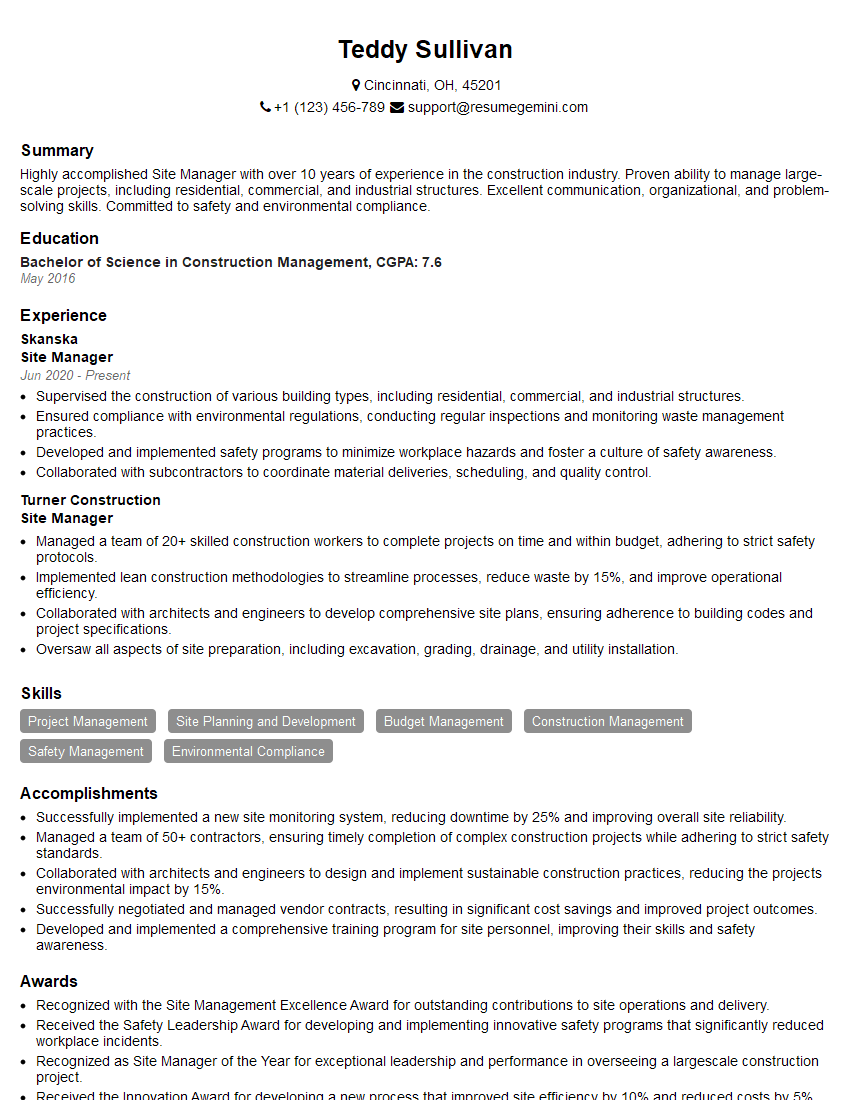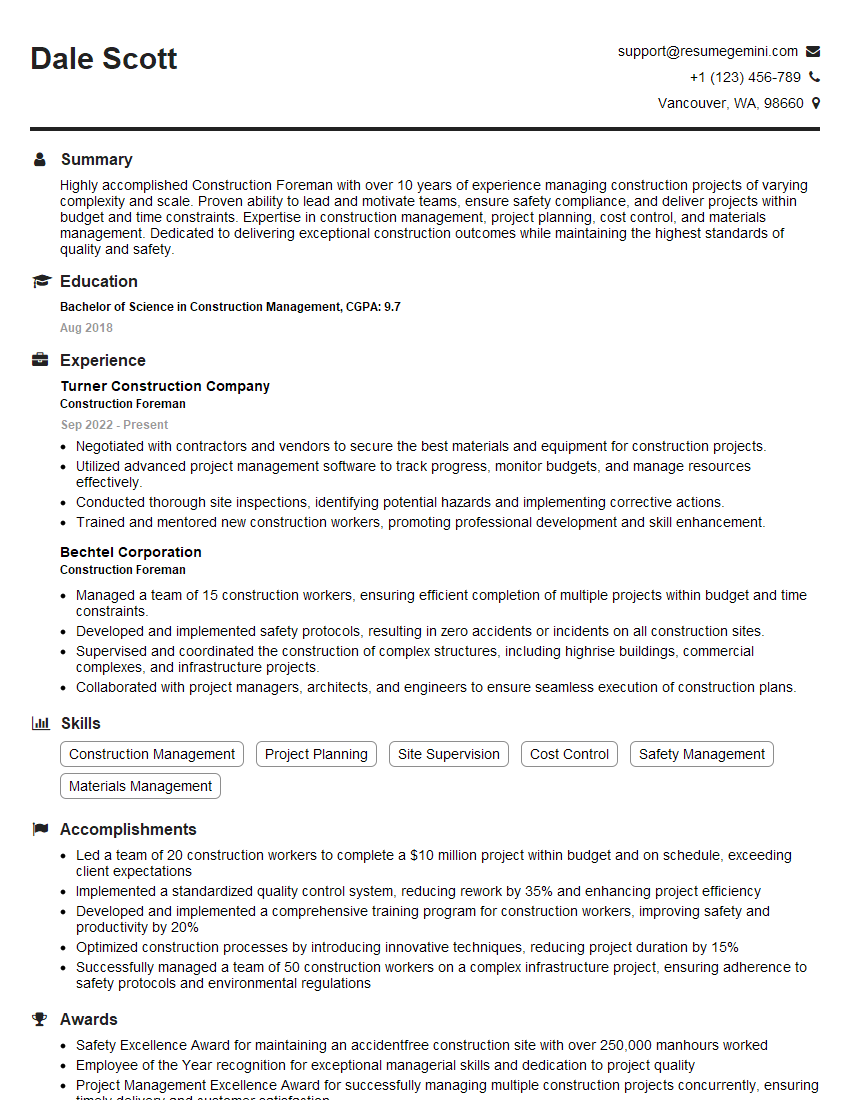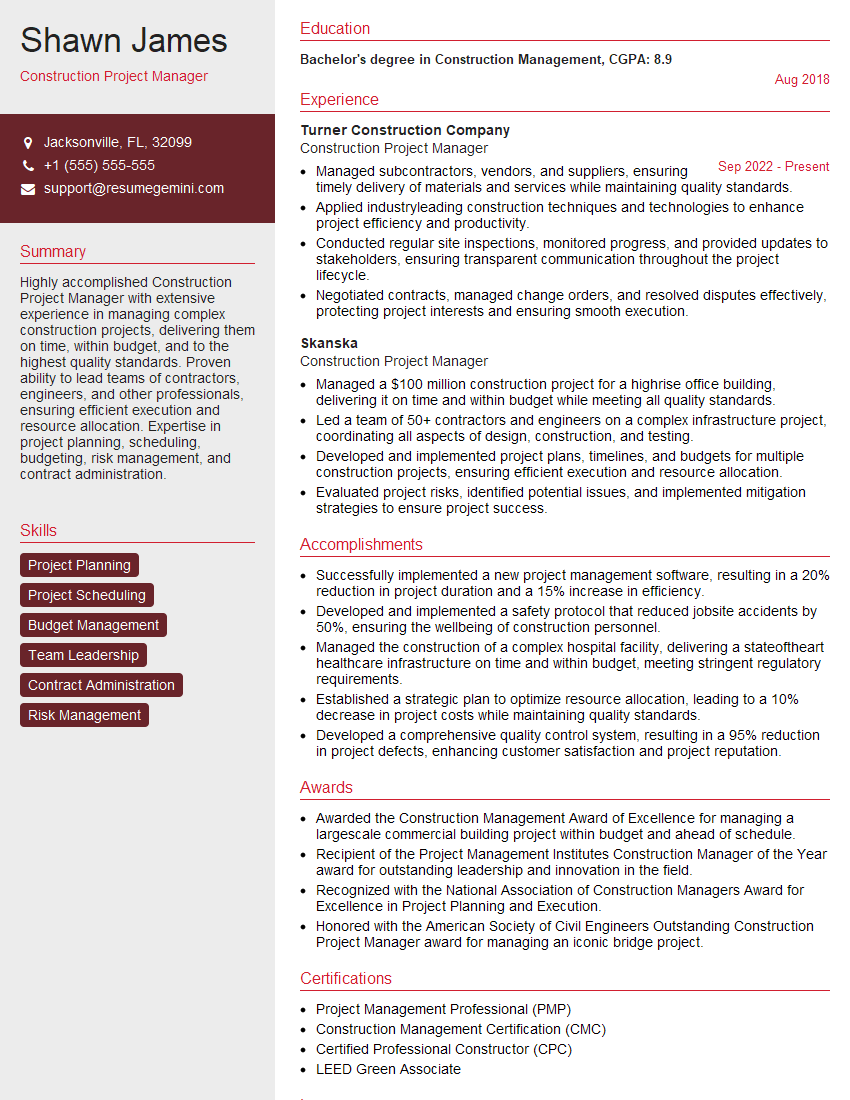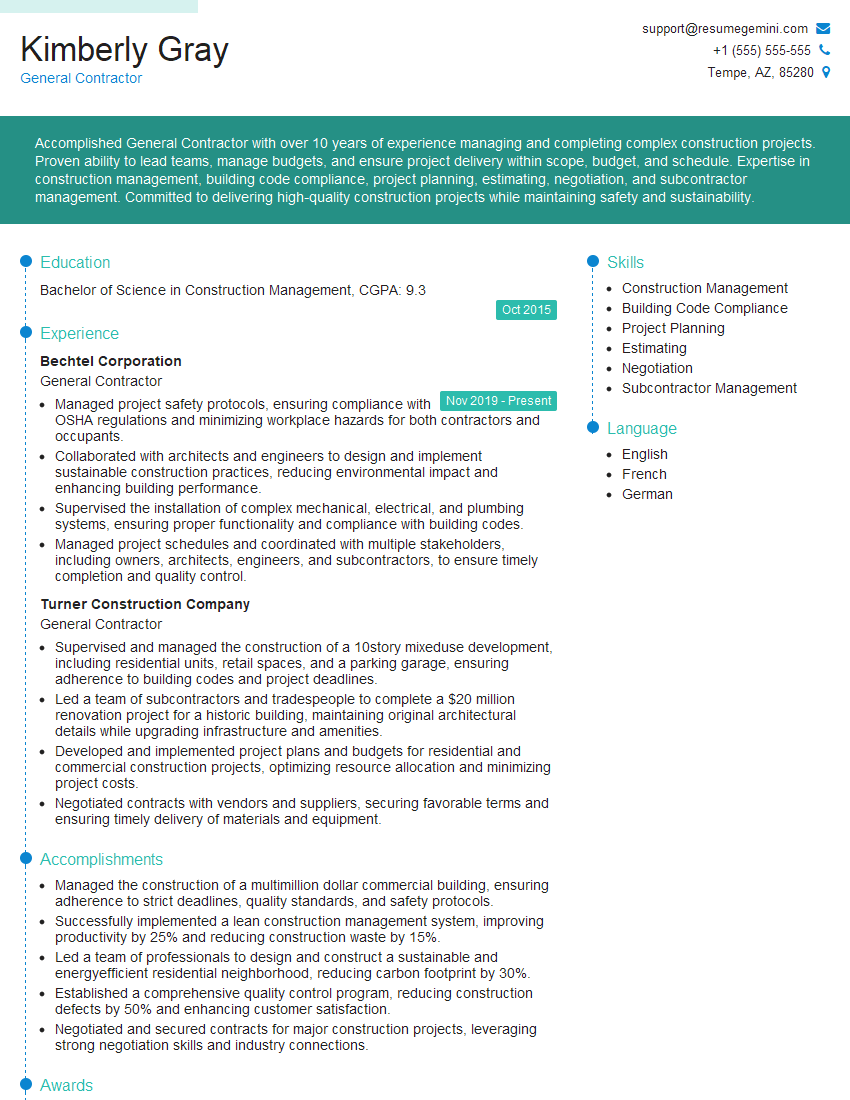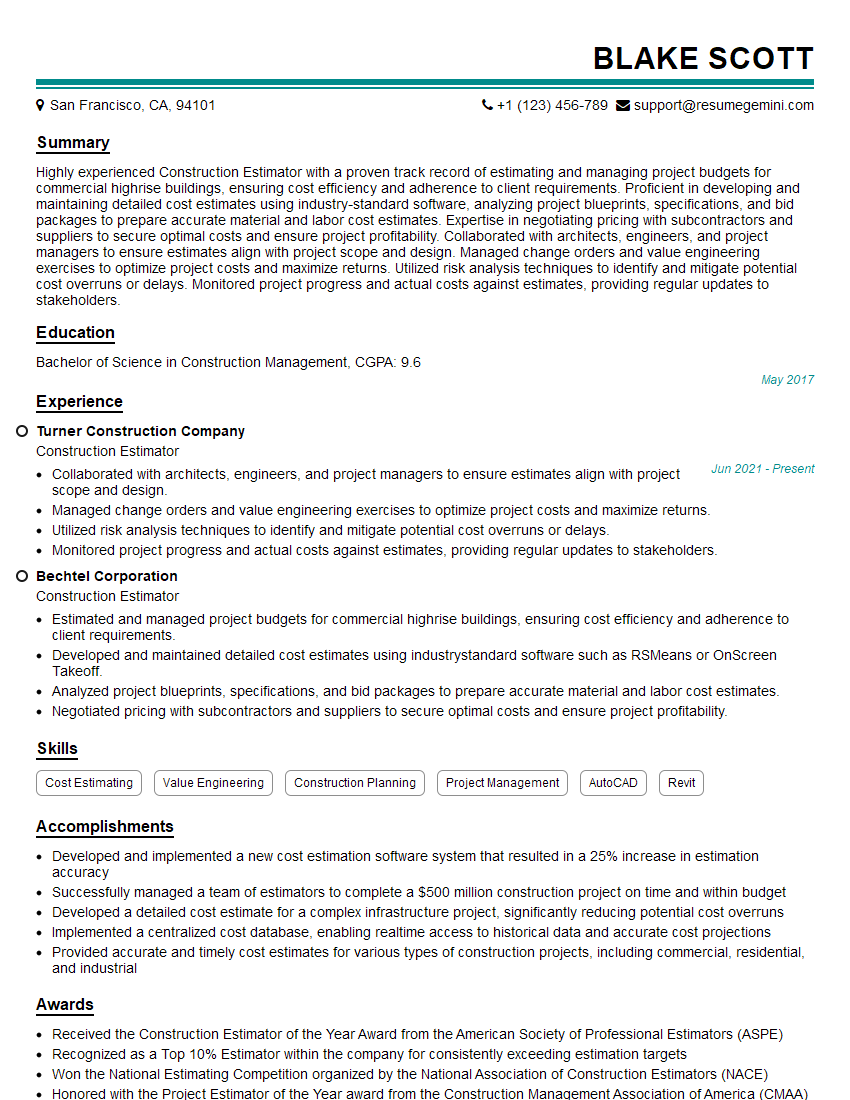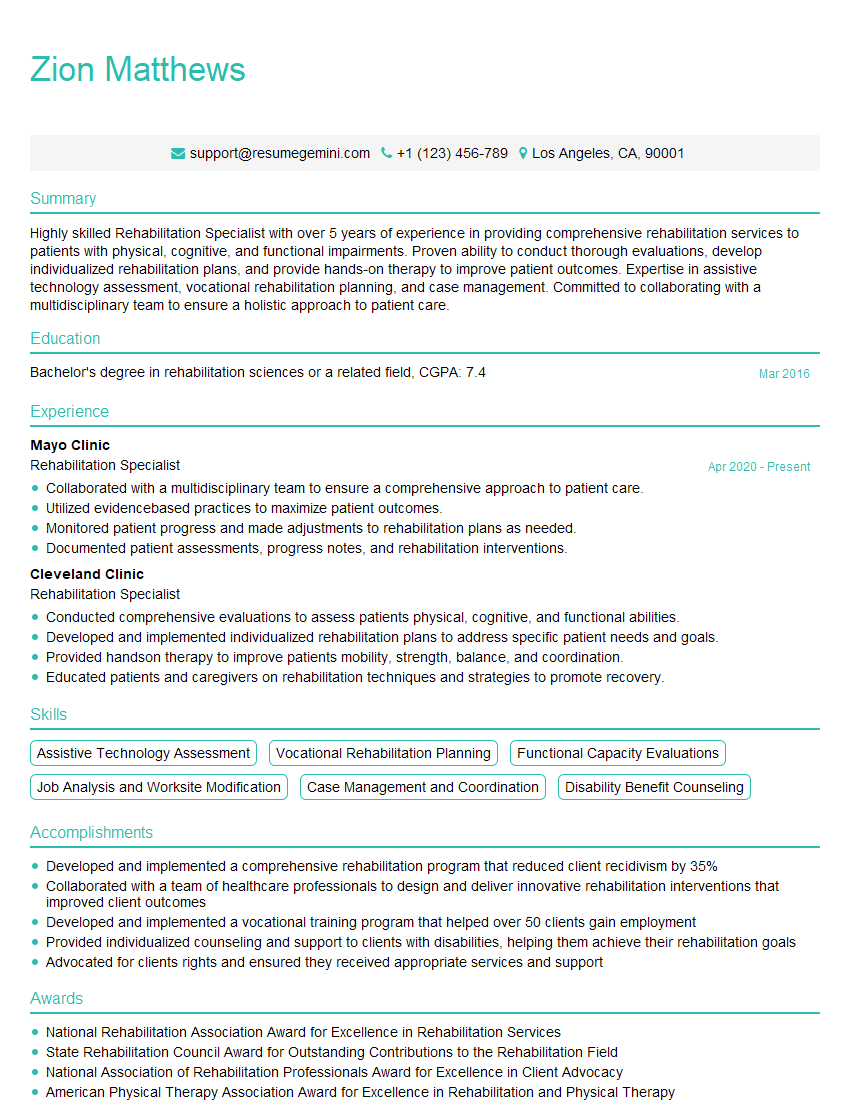The right preparation can turn an interview into an opportunity to showcase your expertise. This guide to Renovation and Remodeling Experience interview questions is your ultimate resource, providing key insights and tips to help you ace your responses and stand out as a top candidate.
Questions Asked in Renovation and Remodeling Experience Interview
Q 1. Describe your experience with different construction materials.
My experience spans a wide range of construction materials, from traditional to cutting-edge options. I’m proficient in working with various types of wood, including hardwoods like oak and cherry for high-end finishes, and softer woods like pine for more budget-friendly projects. I have extensive experience with different types of drywall, understanding the nuances of fire-rated and moisture-resistant options. My knowledge extends to concrete, both in its poured and pre-cast forms, including understanding the different mixes and finishes available. I’m also familiar with various tile types – ceramic, porcelain, natural stone – and understand their installation requirements and maintenance. Furthermore, I’m experienced in working with various metals, such as steel for structural support and aluminum for framing and exterior cladding. Finally, I stay updated on newer materials like engineered wood products and sustainable building materials to offer clients the best possible solutions.
For example, on a recent kitchen renovation, we used reclaimed wood beams for a rustic aesthetic, complementing high-end porcelain tiles for durability and easy maintenance. The choice of materials was directly influenced by the client’s design preferences and budget considerations.
Q 2. What project management methodologies are you familiar with?
I’m adept at employing several project management methodologies, tailoring my approach to the specific project’s scope and complexity. Agile methodologies, with their iterative approach and flexibility, are particularly useful for renovation projects where changes and client feedback are common. I use Kanban boards to visualize tasks and track progress, ensuring transparency and accountability. For larger, more complex projects, I utilize critical path method (CPM) scheduling to identify and manage dependencies between tasks, mitigating potential delays. Ultimately, my goal is to deliver projects on time and within budget, regardless of the chosen methodology. I also incorporate elements of Lean project management, constantly seeking ways to eliminate waste and improve efficiency throughout the renovation process.
Q 3. Explain your approach to budgeting and cost control on renovation projects.
Budgeting and cost control are critical aspects of any successful renovation. My approach begins with a detailed breakdown of all project costs, including materials, labor, permits, and contingency funds. I work closely with clients to develop a realistic budget based on their needs and aspirations. We use detailed line-item estimates, ensuring transparency and allowing for informed decision-making. Throughout the project, I rigorously track expenses against the budget, proactively addressing any potential overruns. Regular progress meetings with the client ensure alignment and address any emerging cost concerns. I utilize project management software to monitor spending and identify areas for potential savings. For example, I might suggest cost-effective alternatives without compromising on quality or design, or negotiate better pricing with suppliers based on project volume.
Q 4. How do you handle unexpected issues or delays during a renovation?
Unexpected issues are inevitable in renovation projects. My approach prioritizes proactive problem-solving and clear communication. When an unforeseen issue arises, I immediately assess its impact on the schedule and budget. I then develop a contingency plan, consulting with the client to find the best course of action. This might involve adjusting the project scope, finding alternative solutions, or negotiating with subcontractors to accommodate unforeseen delays. Transparency with the client is key, keeping them informed every step of the way. For example, if we discover hidden damage behind a wall, I’ll document the problem, provide a cost estimate for repair, and explore options with the client to minimize disruption and extra expenses. I view these challenges as opportunities to demonstrate my problem-solving skills and commitment to client satisfaction.
Q 5. Describe your experience with permitting and code compliance.
Navigating permits and code compliance is a crucial aspect of my work. I have extensive experience in obtaining the necessary permits for various renovation projects, working closely with local authorities to ensure compliance with all building codes and regulations. This includes submitting detailed plans, obtaining inspections, and addressing any concerns or modifications required by the authorities. My goal is to ensure a smooth and timely permitting process, minimizing potential delays and avoiding costly fines or project shutdowns. I maintain thorough records of all permits and inspections, readily accessible to the client and relevant authorities. Understanding local building codes is critical, and I stay informed about updates and changes to ensure compliance throughout the project.
Q 6. What safety protocols do you follow on construction sites?
Safety is paramount on all my construction sites. I implement and enforce strict safety protocols, complying with all OSHA regulations and industry best practices. This includes regular safety meetings with the team, providing appropriate personal protective equipment (PPE), and ensuring proper use of machinery and tools. I prioritize risk assessment and hazard mitigation, proactively identifying and addressing potential safety issues. Proper site organization, including clear walkways and designated storage areas, is crucial for preventing accidents. Furthermore, regular inspections are carried out to maintain a safe and organized work environment. I have a zero-tolerance policy towards unsafe practices and always encourage open communication regarding safety concerns.
Q 7. How do you communicate effectively with clients and subcontractors?
Effective communication is essential for successful renovations. I utilize various channels to communicate with clients and subcontractors, ensuring transparency and keeping everyone informed throughout the project. Regular project update meetings with clients keep them engaged and aware of progress. I use email and project management software for detailed updates and documentation. With subcontractors, clear contracts define responsibilities, timelines, and payment terms. Regular on-site communication helps to address issues promptly and efficiently. Open and honest communication fosters trust and ensures a positive working relationship with all parties involved. I strive to be readily available to answer questions and address concerns in a timely and professional manner.
Q 8. Explain your experience with different types of renovations (e.g., kitchen, bathroom, whole-house).
My experience spans a wide range of renovation projects, from individual room makeovers to complete house overhauls. I’ve tackled numerous kitchen renovations, encompassing everything from simple cabinet refacing and appliance upgrades to full-scale gut jobs with custom cabinetry, island installations, and updated plumbing and electrical systems. For example, I recently completed a kitchen renovation that involved integrating smart appliances and a custom-designed pantry system, significantly improving both functionality and aesthetics. Bathroom renovations are another area of expertise. I’ve handled projects ranging from basic fixture replacements to complex designs involving walk-in showers, heated floors, and spa-like features. One memorable project involved transforming a cramped, outdated bathroom into a luxurious master suite with a soaking tub and double vanity. Whole-house renovations are a significant undertaking, requiring meticulous planning and coordination. I’ve managed several of these, coordinating multiple tradespeople, managing budgets, and ensuring projects are completed on time and within budget. A recent whole-house renovation included structural changes, a complete re-wiring and plumbing update, and a significant expansion of the living space, showcasing my ability to handle complex projects effectively.
Q 9. How do you manage a project timeline and deadlines?
Managing project timelines and deadlines requires a meticulous approach. I begin by developing a detailed project schedule, breaking down the work into smaller, manageable tasks with assigned deadlines for each. This schedule utilizes critical path method (CPM) analysis to identify tasks crucial to overall project completion and prioritize resource allocation to these tasks. I use Gantt charts to visualize progress and identify potential delays. Regular progress meetings with the client and subcontractors are crucial. These meetings involve reviewing progress against the schedule, addressing any roadblocks, and making necessary adjustments. Communication is paramount; I maintain open and clear lines of communication with all stakeholders to proactively address any issues that may impact the timeline. I’ve found that proactive problem-solving is key – anticipating potential delays and having contingency plans in place minimizes disruptions. For instance, in one project, unforeseen delays in material delivery were mitigated by having alternative materials on standby and adjusting the work schedule accordingly. This allowed for project completion within the agreed-upon timeline.
Q 10. What software programs are you proficient in (e.g., AutoCAD, Revit)?
I’m proficient in several software programs crucial for renovation and remodeling. AutoCAD is my primary tool for creating detailed 2D drawings and plans, including floor plans, elevations, and sections. I use it to design layouts, detail construction elements, and prepare construction documents. Revit is another essential tool; I use its 3D modeling capabilities to visualize designs, coordinate building systems, and produce construction documents. Its ability to manage building information modeling (BIM) enhances the collaboration between the different stakeholders in a project. I also utilize SketchUp for quick concept sketches and 3D visualizations that help clients visualize the finished product. Finally, Microsoft Project is a critical tool for project management, aiding in creating and tracking project schedules and resources. This software allows me to efficiently manage time constraints and budgets.
Q 11. Describe your experience with different types of contracts.
My experience encompasses various types of contracts, including fixed-price contracts, cost-plus contracts, and time and materials contracts. Fixed-price contracts are best suited for projects with clearly defined scopes and minimal anticipated changes. They provide certainty in the overall cost, but require a thorough understanding of the project scope upfront. Cost-plus contracts are suitable for projects with a less defined scope, allowing for flexibility and adjustments along the way. However, they require careful tracking and management of costs. Time and materials contracts are used when the project scope is highly uncertain. They offer flexibility, but require meticulous tracking of time and materials used to avoid cost overruns. I’m comfortable working with all contract types and choosing the most suitable one based on the specific project requirements and client needs. Each contract is clearly articulated, outlining expectations, responsibilities, payment terms, and dispute resolution mechanisms.
Q 12. How do you ensure quality control throughout a renovation project?
Quality control is a continuous process throughout the renovation project. It begins with careful material selection, ensuring that only high-quality materials are used that meet specified standards. Regular on-site inspections are conducted to monitor the work quality of subcontractors. Detailed checklists are used to ensure that each stage of construction meets the required quality standards. This approach includes examining the craftsmanship of each phase and inspecting materials for compliance with specifications. A thorough quality assurance review process occurs before the final inspection. This includes revisiting every detail to make sure it aligns with the agreed-upon plans and specifications. Documentation of all inspections and any issues found is crucial. This documentation becomes part of the project’s record and helps to resolve disputes or improve future project processes. Addressing any issues promptly prevents escalation and protects the project’s quality.
Q 13. How do you manage risks and potential problems on a renovation site?
Risk management is crucial in renovation projects. I identify potential risks early using risk assessment matrices, considering factors like material availability, weather conditions, and unforeseen structural issues. Developing mitigation strategies for each identified risk is critical. This can include having backup plans for material delivery, scheduling work around inclement weather, or budgeting for potential unforeseen repairs. Regular monitoring and communication are essential for early detection of potential problems. Open communication channels with subcontractors, suppliers, and the client help in identifying and addressing issues quickly. For example, if a structural issue is discovered during demolition, I’ll immediately contact structural engineers, adjust the project schedule, and inform the client of the situation and potential cost implications. This proactive approach minimizes disruption and ensures the project remains on track.
Q 14. What is your experience with sustainable and green building practices?
I have considerable experience incorporating sustainable and green building practices into renovation projects. This includes using energy-efficient appliances, low-VOC (volatile organic compound) paints and finishes, and recycled or reclaimed materials wherever possible. Strategies include improving insulation to reduce energy consumption, installing energy-efficient windows and doors, and designing for natural ventilation to minimize reliance on HVAC systems. Water conservation is another focus, utilizing low-flow fixtures, rain harvesting systems (where feasible), and drought-tolerant landscaping. I also prioritize the responsible disposal of construction waste, recycling and diverting materials from landfills whenever possible. In one recent project, we used reclaimed wood for flooring, significantly reducing the project’s carbon footprint. This commitment not only benefits the environment but also often leads to cost savings in the long run by reducing energy consumption and resource usage.
Q 15. How do you handle customer complaints or concerns?
Handling customer complaints starts with active listening and empathy. I believe in understanding their perspective before offering solutions. I begin by acknowledging their frustration and assuring them I’m committed to resolving the issue. Then, I carefully document the complaint, including specifics like dates, locations, and witnesses.
Next, I investigate the root cause. This might involve reviewing project plans, speaking with subcontractors, or even revisiting the job site. Once I understand the problem, I present a clear, concise plan of action, including a timeline for resolution and, where appropriate, a fair compensation plan. For example, if a finish wasn’t to the customer’s liking due to a subcontractor’s error, I’d immediately arrange for a correction, ensuring it aligns with the agreed-upon standards and paying for any additional costs incurred. Finally, I follow up with the customer to ensure their satisfaction and gather feedback to improve future processes.
Career Expert Tips:
- Ace those interviews! Prepare effectively by reviewing the Top 50 Most Common Interview Questions on ResumeGemini.
- Navigate your job search with confidence! Explore a wide range of Career Tips on ResumeGemini. Learn about common challenges and recommendations to overcome them.
- Craft the perfect resume! Master the Art of Resume Writing with ResumeGemini’s guide. Showcase your unique qualifications and achievements effectively.
- Don’t miss out on holiday savings! Build your dream resume with ResumeGemini’s ATS optimized templates.
Q 16. Describe your experience with negotiating contracts with subcontractors.
Negotiating contracts with subcontractors is a crucial part of project success. I approach negotiations with a collaborative mindset, aiming for a win-win situation. I start by clearly outlining the scope of work, including detailed specifications, timelines, and payment schedules. I use a standardized contract that’s been reviewed by legal counsel, ensuring all clauses are fair and protective for both parties.
During negotiations, I focus on factors beyond just price, considering factors such as the subcontractor’s experience, reputation, insurance coverage, and commitment to safety. I’ve found that building strong, trusting relationships with subcontractors results in better quality work and fewer disputes. For instance, on a recent project involving intricate millwork, I carefully selected a subcontractor known for their precision and attention to detail, even though their initial quote was slightly higher. The result was superior craftsmanship that exceeded the client’s expectations, ultimately benefiting the project.
Q 17. Explain your experience with preparing detailed project proposals.
Preparing detailed project proposals is fundamental for securing projects and setting expectations. My proposals begin with a thorough understanding of the client’s needs, which I gather through in-depth consultations. The proposal includes a comprehensive overview of the project, a detailed scope of work with specifications and quantities, a realistic timeline, a detailed budget breakdown with contingency planning, and a clear description of my company’s processes and quality control measures.
I use visual aids like sketches, 3D renderings, and material samples to help clients visualize the final result. For example, for a kitchen renovation, I would provide detailed renderings showing the layout, cabinet styles, and countertop selections. Clarity and transparency are paramount. Any potential risks or challenges are proactively addressed, and alternative solutions are suggested. This allows the client to make informed decisions and fosters trust.
Q 18. How do you manage the flow of materials to the job site?
Managing material flow to the job site efficiently requires meticulous planning and coordination. I begin by creating a detailed material schedule that aligns with the project timeline, ordering materials well in advance to avoid delays. This involves working closely with suppliers to ensure timely delivery. I utilize a robust system for tracking materials, often leveraging project management software to monitor quantities, delivery dates, and on-site storage.
On-site, materials are organized strategically to minimize clutter and maximize efficiency. I establish clear labeling and storage procedures to avoid damage or mix-ups. Just-in-time delivery is often employed for certain materials to avoid unnecessary storage costs and potential damage. For instance, on a large-scale renovation project, I scheduled deliveries to coincide with the installation phases, preventing overcrowding and maximizing space utilization.
Q 19. What is your experience with different types of foundations?
My experience encompasses various foundation types, including slab-on-grade, crawl space, and basement foundations. Understanding their unique characteristics is crucial for successful renovations and repairs. Slab-on-grade foundations are common in warmer climates and require careful consideration during renovations to avoid compromising structural integrity. Crawl space foundations need attention to moisture control and proper ventilation.
Basement foundations present opportunities for expansion but necessitate careful evaluation for waterproofing and structural soundness. For example, during a basement finishing project, I had to address some existing cracks in the foundation walls. I engaged a structural engineer to assess the situation, and we implemented appropriate repair measures, including waterproofing and reinforcement, before proceeding with the finishing work. This ensured the longevity and safety of the finished basement.
Q 20. Describe your experience with structural repairs and renovations.
Structural repairs and renovations require a deep understanding of building codes, engineering principles, and construction techniques. My experience includes handling various structural issues, such as load-bearing wall removal, beam installation, foundation stabilization, and the repair of damaged framing members. Before undertaking any structural work, I always consult with engineers to ensure the project meets safety standards.
I utilize advanced techniques and materials to strengthen and stabilize structures. For example, during a renovation where a load-bearing wall needed to be removed, we carefully engineered the structural modifications, implementing steel beams and headers to maintain the building’s structural integrity. Detailed documentation, including engineering calculations and inspections, is maintained throughout the entire process to ensure compliance and safety.
Q 21. How do you ensure the project stays within the agreed-upon budget?
Staying within budget is paramount. I achieve this through meticulous planning, accurate cost estimation, and diligent tracking of expenses. My detailed proposals include a comprehensive budget breakdown, itemizing all costs. I regularly review the project’s progress against the budget, using project management software to track expenses and identify potential cost overruns.
Open communication with clients is crucial. Any unexpected costs or changes in scope are discussed transparently and promptly. I proactively seek cost-effective solutions without compromising quality. For example, on a recent project where material costs unexpectedly increased, I collaborated with the client to explore alternative materials that achieved similar aesthetics at a more reasonable price, keeping the project on budget without sacrificing the overall design.
Q 22. What are your preferred methods for documenting project progress?
Documenting project progress is crucial for successful renovation projects. My preferred methods combine digital and physical documentation for a comprehensive record. I utilize a project management software (like Asana or Trello) to track tasks, deadlines, and individual trade progress. This allows for easy visual tracking of the project timeline and immediate notification of any delays. In addition to this, I maintain a detailed photographic record of each stage. This is extremely helpful in case of disputes, insurance claims, or simply to show clients the progress visually. Finally, I create regular written reports summarizing the week’s activities, challenges encountered, and plans for the following week. These reports are shared with the client and relevant stakeholders.
- Project Management Software: Provides a centralized hub for tasks, deadlines, and communication.
- Photography: Captures visual evidence of progress and any potential issues.
- Weekly Reports: Offers a concise summary of progress and upcoming plans.
Q 23. Explain your experience working with different types of blueprints and drawings.
My experience encompasses working with a wide array of blueprints and drawings, including architectural plans, structural drawings, MEP (Mechanical, Electrical, Plumbing) plans, and detailed shop drawings. I’m proficient in interpreting various scales and notations, understanding symbols and specifications. For example, I’ve worked with both hand-drawn blueprints (less common now but vital to understanding historic renovation projects) and sophisticated 3D models created using software like AutoCAD or Revit. The key is to be able to extract the necessary information regardless of the format. When discrepancies exist between different drawings, I employ a systematic approach of identifying the most current and accurate version, consulting with the architect or engineer for clarification if needed, and documenting all changes or discrepancies. I find that using a large-format digital display makes collaborative reviewing much more effective, allowing all stakeholders to examine even small details simultaneously.
Q 24. How do you handle conflicts between different tradespeople on a job site?
Conflicts between tradespeople are inevitable on any large renovation project. My approach focuses on proactive communication and conflict resolution. Firstly, I clearly define each trade’s scope of work and responsibilities in advance, minimizing potential overlaps or misunderstandings. When a conflict arises, I bring all involved parties together to discuss the issue openly and collaboratively, encouraging active listening and finding a mutually acceptable solution. If a compromise can’t be reached immediately, I might mediate and facilitate the discussion, proposing solutions to ensure the project stays on track. In rare instances, if the disagreement significantly impacts the project, I may need to involve the architect or a neutral third party to help resolve the situation. Documentation of the conflict, the resolution and any agreement reached is vital.
For example, on a recent project, a disagreement arose between the electrician and the plumber regarding the placement of certain pipes and wiring. Instead of letting it escalate, I facilitated a meeting where both tradespeople could express their concerns and suggest alternative solutions. We eventually found a way to reposition the elements without compromising either trade’s work, keeping the project on schedule.
Q 25. Describe your experience with scheduling and coordinating various trades.
Scheduling and coordinating various trades requires meticulous planning and proactive communication. I use a combination of digital scheduling tools and physical timelines to ensure a smooth workflow. I create a detailed schedule that considers each trade’s dependencies and estimated duration. For example, the foundation work must be completed before framing can begin, and plumbing needs to be installed before drywall. I maintain open communication with each trade throughout the project, providing regular updates on the schedule and addressing any potential delays. Contingency plans are vital, and I always build in buffer time for unexpected issues. This proactive approach prevents major delays and keeps the project on budget. Regular meetings with all trades are also key, allowing early identification and mitigation of scheduling conflicts. Thinking like an orchestra conductor – each instrument (trade) has its own part and must play in harmony and time to produce a beautiful result is a great analogy for me.
Q 26. What is your process for final inspections and project handover?
Final inspections and project handover are critical steps ensuring client satisfaction and project completion. My process begins with a thorough walkthrough with the client, checking all aspects of the renovation against the initial plans and specifications. I address any minor snags or outstanding items, creating a detailed punch list to track remaining tasks. Once the punch list is completed and verified by the client, I conduct a final inspection, ensuring all aspects meet building codes and safety standards. All relevant documentation (including warranties, permits, and maintenance instructions) is compiled and provided to the client. I schedule a final meeting to formally hand over the completed project, ensuring client understanding of maintenance procedures and any future service requirements. This methodical approach, focusing on clear communication and documented handovers, is fundamental to a successful project conclusion.
Q 27. What is your approach to managing waste and debris during a renovation?
Managing waste and debris is crucial for both environmental responsibility and job site safety. My approach is twofold: prevention and efficient disposal. Firstly, we minimize waste generation through careful planning and material selection. Secondly, we employ a systematic approach to waste segregation and disposal, separating materials according to local regulations (e.g., wood, metal, drywall, etc.). This allows for efficient recycling and reduces landfill waste. I use reputable waste management companies with appropriate licenses to ensure safe and responsible disposal practices. Maintaining a clean and organized job site not only promotes safety but also enhances productivity. Clear labeling of waste containers and regular removal of debris are essential components of this strategy.
Q 28. How do you stay current with the latest industry trends and best practices?
Staying current with industry trends and best practices is paramount for continued success. I achieve this through a multifaceted approach. I actively participate in industry conferences and workshops, attending seminars and training sessions focused on the latest technologies, materials, and techniques. Professional organizations offer valuable insights. I also subscribe to relevant trade publications, read industry blogs, and follow key influencers on social media to keep abreast of emerging trends. Moreover, I frequently network with other professionals in the field, exchanging knowledge and best practices. This holistic approach keeps my skills sharp and ensures I can offer clients the most innovative and effective solutions available.
Key Topics to Learn for Renovation and Remodeling Experience Interview
- Project Management in Renovations: Understanding project timelines, budgeting, and resource allocation. Practical application: Describe a past project where you successfully managed competing priorities and deadlines.
- Building Codes and Regulations: Familiarity with local and national building codes, safety regulations, and permit processes. Practical application: Explain how you ensured compliance with building codes on a previous project.
- Material Selection and Estimation: Knowledge of various building materials, their properties, and cost-effective selection. Practical application: Discuss your experience in specifying materials and managing material costs within a budget.
- Client Communication and Management: Effective communication with clients, managing expectations, and resolving conflicts. Practical application: Describe a situation where you successfully navigated a challenging client interaction.
- Teamwork and Collaboration: Working effectively with subcontractors, designers, and other professionals. Practical application: Detail your experience collaborating with a team to achieve a project goal.
- Problem-Solving and Troubleshooting: Identifying and resolving unexpected issues during the renovation process. Practical application: Describe a time you encountered a significant problem on a project and how you solved it.
- Safety Procedures and Practices: Understanding and implementing safety protocols on construction sites. Practical application: Explain your experience with maintaining a safe work environment.
- Renovation Techniques and Methodologies: Understanding various renovation approaches, such as demolition, framing, finishing, and restoration. Practical application: Discuss your expertise in specific renovation techniques.
Next Steps
Mastering Renovation and Remodeling Experience is crucial for career advancement in this dynamic field. A strong understanding of project management, building codes, and client communication will significantly enhance your job prospects. Creating an ATS-friendly resume is essential to get your application noticed by potential employers. ResumeGemini is a trusted resource to help you build a professional and effective resume. Take advantage of the examples of resumes tailored to Renovation and Remodeling Experience provided to help you showcase your skills and experience.
Explore more articles
Users Rating of Our Blogs
Share Your Experience
We value your feedback! Please rate our content and share your thoughts (optional).
What Readers Say About Our Blog
Hello,
We found issues with your domain’s email setup that may be sending your messages to spam or blocking them completely. InboxShield Mini shows you how to fix it in minutes — no tech skills required.
Scan your domain now for details: https://inboxshield-mini.com/
— Adam @ InboxShield Mini
Reply STOP to unsubscribe
Hi, are you owner of interviewgemini.com? What if I told you I could help you find extra time in your schedule, reconnect with leads you didn’t even realize you missed, and bring in more “I want to work with you” conversations, without increasing your ad spend or hiring a full-time employee?
All with a flexible, budget-friendly service that could easily pay for itself. Sounds good?
Would it be nice to jump on a quick 10-minute call so I can show you exactly how we make this work?
Best,
Hapei
Marketing Director
Hey, I know you’re the owner of interviewgemini.com. I’ll be quick.
Fundraising for your business is tough and time-consuming. We make it easier by guaranteeing two private investor meetings each month, for six months. No demos, no pitch events – just direct introductions to active investors matched to your startup.
If youR17;re raising, this could help you build real momentum. Want me to send more info?
Hi, I represent an SEO company that specialises in getting you AI citations and higher rankings on Google. I’d like to offer you a 100% free SEO audit for your website. Would you be interested?
Hi, I represent an SEO company that specialises in getting you AI citations and higher rankings on Google. I’d like to offer you a 100% free SEO audit for your website. Would you be interested?
good
